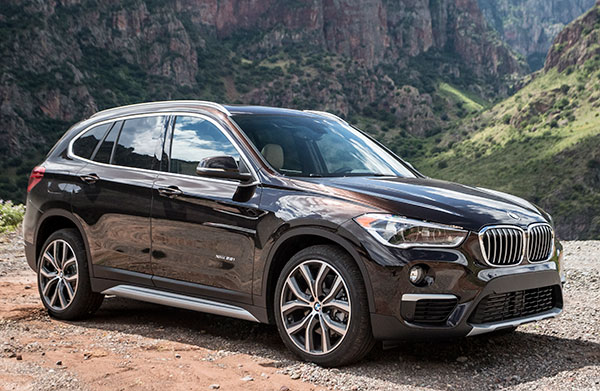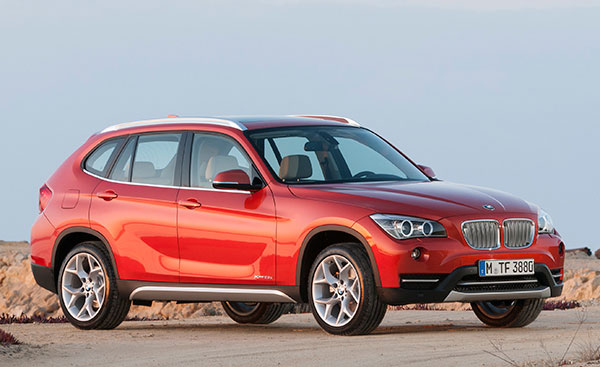

an account. You can:
Access your saved cars on any device.
Receive Price Alert emails when price changes,
new offers become available or a vehicle is sold.


Model Overview of The BMW X1's For Sale in Middletown, CT
2016 BMW X1 Information
2016 BMW X1
The 2016 BMW X1 has been redesigned, and to many its a relief, because it now looks like the crossover it is, not a hatchback. The all-new X1 Sports Activity Vehicle has grown two inches taller and one inch wider, on a track thats two inches wider, and an length thats a touch shorter. The headlights are in the top corners of the front fascia, and taillights in the top corners of the rear fascia, adding to the unhatchback-like look.
The only model, the all-wheel-drive BMW X1 xDrive 28i, uses a turbocharged 2.0-liter four-cylinder engine making 228 horsepower and a strong 258 pound-feet of torque. Its mated to paddle-shifting 8-speed automatic transmission, and there are three drive modes: Comfort, Sport and Eco. It can go from zero to 60 in a sprightly 6.3 seconds, and gets 22 miles per gallon City and 32 mpg Highway. Mostly, its fun to drive, with a sweet engine and handling thats quick and nimble. Not many crossovers offer that.
Whats more, four adults will be happy inside. Technically, it seats five, but three of them would need to be kids.
Its hard to say what cars the X1 competes against. You might say a fully loaded Honda CR-V or Ford Escape, both much less fun to drive, more likely the Audi Q3 or the Range Rover Evoque. Maybe the Acura RDX or Volvo XC60.
In order to keep the X1s price in the Honda/Ford neighborhood, the X1 is relatively slim in standard features, for a BMW. For example leather isnt standard, nor is navigation or a rearview camera.
The Insurance Institute for Highway Safety (IIHS) hasnt rated the 2016 X1. The National Highway Traffic Safety Administration (NHTSA) hasnt tested the X1 at all, because its not a high-volume model.
2014 BMW X1 Information
2014 BMW X1
Popular in Europe after going on sale four years ago, the BMW X1 subcompact SUV arrived in the U.S. as a 2013 model. Based on the BMW 1 Series hatchback (which is not sold in the U.S.), the X1 is BMW's tiniest SUV, smaller than the X3.
The 2014 BMW X1 lineup offers Harman Kardon Surround Sound as a standalone option. Otherwise, except for a new upholstery color that's available, nothing has changed for the 2014 model year.
From a certain perspective, the BMW X1 makes fiscal sense, because it makes the X Series available to buyers who lust for a BMW crossover but don't feel they can step up to the price of an X3 or X5. The base price gap between X1 and X3 is about $9,000, but the X3 comes standard with all-wheel drive, whereas the base X1 sDrive28i is rear-wheel drive. This isn't as vast an economic chasm as the numbers suggest, however. Adding just a couple of option groups to an X1 can put you well into X3 territory.
Based on the solid architecture that supports the 1 Series sedan (derived from the last-generation 3 Series), the X1 offers about the same interior volume as that 3 Series wagon, even though it's 2.1 inches shorter overall.
BMW X1 dimensions are substantially tidier than those of the X3, making the X1 handier in urban operating conditions; and of course, lighter than its bigger cousin, which pays off at the gas station. Even with all-wheel drive, the BMW X1 xDrive28i weighs about 300 pounds less, and delivers a decisive 5 mpg edge in EPA-estimated highway fuel economy.
Commonality with the 1 Series continues under the X1's hood, with two engine options, both turbocharged. The standard engine employed by the BMW X1 sDrive28i and X1 xDrive28i is a 2.0-liter four-cylinder, rated for 240 horsepower and 260 pound-feet of torque. Fuel economy is an EPA-estimated 23/34 mpg City/Highway (22/33 with xDrive). BMW says it can accelerate from 0 to 60 mph in 6.2 seconds.
The upgrade is the smooth and potent 3.0-liter twin turbo six-cylinder, used by the BMW X1 xDrive35i and rated at 300 horsepower at 5800 rpm, with 300 pound-feet of torque at 1300-5000 rpm. It's EPA-rated at 18/27 mpg City/Highway. BMW says it can accelerate from 0 to 60 mph in just 5.3 seconds.
The four-cylinder is paired with an 8-speed automatic transmission, which includes manual shifting, eco, and auto stop/start modes; the 3.0-liter transmits its power through the older 6-speed automatic.
All-wheel drive uses BMW's thoroughly developed xDrive system, used on the BMW X1 xDrive 28i and BMW X1 xDrive35i. The BMW sDrive28i is rear-wheel drive.
Like the other BMW SUVs, the X1 has no off-road pretensions whatsoever; ground clearance is a sedan-like 7.0 inches. All-wheel drive is conceived here as a traction and stability enhancer for driving on low adhesion surfaces, in inclement weather conditions, or both.
The other element of ongoing BMW appeal is a blend of ride and handling that's become a dynamic benchmark for the rest of the industry. Sharing the 1 Series sedan foundations, the BMW X1 hews true to this ethic. Inevitably, it's not quite as agile as the 3 Series sedan or wagon. Heftier curb weights and a high profile dilute the athletic index slightly. Nevertheless, the X1 has the feel and steering response that distinguish all BMWs, and feels a little more nimble than the X3, as well as small crossovers such as the Acura RDX, Land Rover LR2, and Mercedes GLK.
Like the rest of the package, the inner X1 is well conceived to satisfy BMW intenders, both first-timers and veterans. The seating is sporty and supportive, inner appointments are consistent with the entry luxury category (subdued but high quality), and the array of telematics is competitive.
2013 BMW X1 Information
2013 BMW X1
Popular in Europe after going on sale there three years ago, the BMW X1 subcompact SUV is now available in the U.S. Based on the BMW 1 Series sedan, the X1 is BMW's smallest SUV, smaller than the X3.
From a certain perspective, the BMW X1 makes fiscal sense, because it makes the X Series available to buyers who lust for a BMW crossover but don't feel they can step up to the price of an X3 or X5. The base price gap between X1 and X3 is about $8,000, but the X3 comes standard with all-wheel drive, whereas the base X1 sDrive28i is rear-wheel drive. (The 2013 BMW X3 xDrive28i starts at $38,850 MSRP, while a 2013 BMW X3 xDrive28i retails for $32,350.)
This is not an economic chasm. Adding just a couple option groups to an X1 can put you well into X3 territory. Our well-equipped BMW X1 xDrive28i, which retailed for $45,095 as tested, makes a strong case in point. And stepping up to a loaded X1 xDrive35i, with its 300-horsepower 3.0-liter inline six-cylinder turbo engine and all-wheel drive, can swell the total to $50,000 and beyond.
But if the marketing perspective may not make as much financial sense to you as it does to BMW insiders, the X1 makes sense in other ways. Based on the solid architecture that supports the 1 Series sedan (derived from the last generation 3 Series), with the same wheelbase as the 3 Series station wagon, the X1 offers about the same interior volume as the wagon, even though it's 2.1 inches shorter overall.
BMW X1 dimensions are substantially tidier than those of the X3, making the X1 handier in urban operating conditions, and of course lighter than its bigger cousin, which pays off at the scales and the gas station. Even equipped with all-wheel drive, the X1 weighs about 300 pounds lighter, and it delivers a decisive 5 mpg edge in EPA highway fuel economy ratings.
Commonality with the 1 Series continues under the X1's hood, with two engine options, both turbocharged. The standard engine employed by the BMW X1 sDrive28i and X1 xDrive28i, is a 2.0-liter four-cylinder, rated for 240 horsepower and 260 pound-feet of torque. Fuel economy is an EPA-estimated 24/34 mpg City/Highway. BMW says it can accelerate from 0 to 60 mph in 6.2 seconds.
The upgrade is the smooth and potent 3.0-liter twin turbo six-cylinder, used by the BMW X1 xDrive35i and rated at 300 horsepower at 5800 rpm, 300 pound-feet of torque at 1300-5000 rpm. It's EPA-rated at 18/27 mpg City/Highway. BMW says it can accelerate from 0 to 60 mph in just 5.3 seconds.
The four-cylinder is paired with an 8-speed automatic transmission, which includes manual shifting, eco, and auto stop-start modes; the 3.0-liter transmits its power through the older 6-speed automatic.
All-wheel drive uses BMW's thoroughly developed xDrive system used on the BMW X1 xDrive 28i and BMW X1 xDrive35i. The BMW sDrive28i is rear-wheel drive.
Like the other BMW SUVs, the X1 has no off-road pretensions whatsoever; ground clearance is a sedan-like 7.0 inches, and all-wheel drive is conceived here as a traction and stability enhancer for driving on low adhesion surfaces or in inclement weather conditions or both.
Styling doesn't seem to be a particularly risky business for BMW, at least as it affects the X5, the X3, and the X1. Having established a look with the X5, its first-ever SUV, BMW simply reduced the scale, then reduced it again. You could think of it as the incredible shrinking X5, a formula that has been exceptionally successful. In fact, it's not easy to distinguish X1 from X3 unless the two are parked side by side.
The other element of ongoing BMW appeal is a blend of ride and handling that's become a dynamic benchmark for the rest of the industry. Sharing the 1 Series sedan foundations, the BMW X1 hews true to this ethic. Inevitably, it's not quite as agile as the 3 Series sedan or wagon. Heftier curb weights and a high profile dilute the athletic index slightly. Nevertheless, the X1 has the feel and steering response that distinguish all BMWs, and feels a little more nimble than the X3, as well as small crossovers such as the Acura RDX, Land Rover LR2, and Mercedes GLK.
Like the rest of the package, the inner X1 is well conceived to satisfy BMW intenders, both first-timers and veterans. The seating is sporty and supportive, inner appointments are consistent with the entry luxury category (subdued but high quality), and the array of telematics is competitive.


